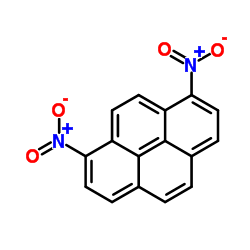Comparative mutagenesis of the C8-guanine adducts of 1-nitropyrene and 1,6- and 1,8-dinitropyrene in a CpG repeat sequence. A slipped frameshift intermediate model for dinucleotide deletion.
Pablo Hilario, Shixiang Yan, Brian E Hingerty, Suse Broyde, Ashis K Basu
文献索引:J. Biol. Chem. 277(47) , 45068-74, (2002)
全文:HTML全文
摘要
In the Ames Salmonella typhimurium reversion assay 1,6- and 1,8-dinitropyrenes (1,6- and 1,8-DNPs) are much more potent mutagens than 1-nitropyrene (1-NP). Genetic experiments established that certain differences in the metabolism of the DNPs, which in turn result in increased DNA adduction, play a role. It remained unclear, however, if the DNP adducts, N-(guanin-8-yl)-1-amino-6 ()-nitropyrene (Gua-C8-1,6-ANP and Gua-C8-1,8-ANP), which contain a nitro group on the pyrene ring covalently linked to the guanine C8, are more mutagenic than the major 1-NP adduct, N-(guanin-8-yl)-1-aminopyrene (Gua-C8-AP). In order to address this, we have compared the mutation frequency of the three guanine C8 adducts, Gua-C8-AP, Gua-C8-1,6-ANP, and Gua-C8-1,8-ANP in a CGCG*CG sequence. Single-stranded M13mp7L2 vectors containing these adducts and a control were constructed and replicated in Escherichia coli. A remarkable difference in the induced CpG deletion frequency between these adducts was noted. In repair-competent cells the 1-NP adduct induced 1.7% CpG deletions without SOS, whereas the 1,6- and 1,8-DNP adducts induced 6.8 and 10.0% two-base deletions, respectively. With SOS, CpG deletions increased up to 1.9, 11.1, and 15.1% by 1-NP, 1,6-, and 1,8-DNP adducts, respectively. This result unequivocally established that DNP adducts are more mutagenic than the 1-NP adduct in the repetitive CpG sequence. In each case the mutation frequency was significantly increased in a mutS strain, which is impaired in methyl-directed mismatch repair, and a dnaQ strain, which carries a defect in proofreading activity of the DNA polymerase III. Modeling studies showed that the nitro group on the pyrene ring at the 8-position can provide additional stabilization to the two-nucleotide extrahelical loop in the promutagenic slipped frameshift intermediate through its added hydrogen-bonding capability. This could account for the increase in CpG deletions in the M13 vector with the nitro-containing adducts compared with the Gua-C8-AP adduct itself.
相关化合物
| 结构式 | 名称/CAS号 | 分子式 | 全部文献 |
|---|---|---|---|
 |
1,8-二硝基芘
CAS:42397-65-9 |
C16H8N2O4 | |
 |
1,6-二硝基芘
CAS:42397-64-8 |
C16H8N2O4 |
|
Mutagenic activity and quantification of nitroarenes in surf...
2003-07-08 [Mutat. Res. 538(1-2) , 121-31, (2003)] |
|
High-performance liquid chromatography-fluorescence determin...
1999-04-16 [J. Chromatogr. A. 839(1-2) , 41-8, (1999)] |
|
Bioactivation of diesel exhaust particle extracts and their ...
2015-01-01 [Mutat. Res. 472(1-2) , 129-38, (2000)] |
|
Dinitropyrenes induce gene mutations in multiple organs of t...
2002-03-25 [Mutat. Res. 515(1-2) , 73-83, (2002)] |
|
Distributions of nitropyrenes and mutagenicity in airborne p...
1995-10-01 [Mutat. Res. 348(2) , 57-61, (1995)] |